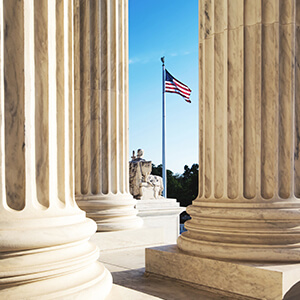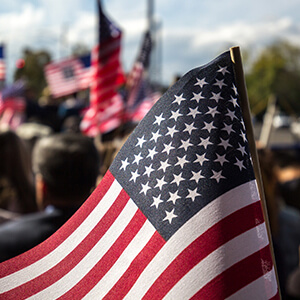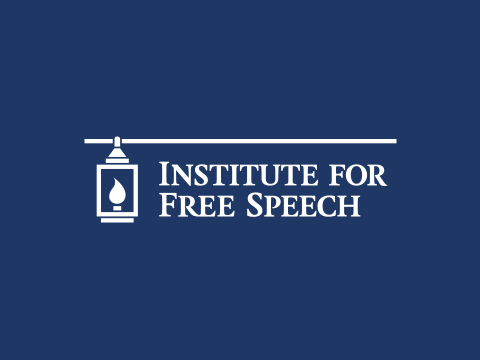On April 26, 1961, the nation’s highest court heard oral arguments in Louisiana ex rel. Gremillion v. NAACP.1 Louisiana’s Assistant Attorney General William P. Schuler stepped up to the lectern to try and persuade the Supreme Court of the United States that his state’s effort to compel the disclosure of the names and addresses of members of the NAACP was constitutional. His arguments were in vain; the NAACP won the case 9-0. Six decades later, on April 26, 2021, California’s Deputy Solicitor General Aimee A. Feinberg didn’t fare much better in Americans for Prosperity Foundation (AFPF) v. Bonta when she tried to defend the state’s rule that forced charities to disclose the names of their major donors before the groups could solicit in the state.2 AFPF won the case 6-3, with the Court issuing an opinion that cited Gremillion.
April 26 represents an important date in the history of associational freedom at the Supreme Court.
Defending the NAACP v. Alabama ex rel. Patterson Precedent
The Supreme Court’s robust commitment to defending membership and donor privacy, grounded in the First Amendment’s freedom of assembly clause, dates back to 1958, when the Court ruled in favor of the NAACP in NAACP v. Alabama ex rel. Patterson, a landmark freedom of association and freedom of speech ruling.3 The civil rights organization was involved in a fight for its survival in Alabama after that state’s Attorney General John M. Patterson filed suit in 1956, seeking to prevent the NAACP from “doing business” in the state until such time that the organization turned over copies of its Alabama membership lists. As the organization noted in its filings in the case, the litigation could “only be understood when examined in the light of conditions existing in Alabama.” In short, “there existed such a state-wide atmosphere of hostility to petitioner that the production of the names of petitioner’s members in Alabama would subject them to economic reprisals, loss of employment, mental harassment, threatened and actual violence.”4
The Court took note of this, and in his opinion for the unanimous Court, Justice John Marshall Harlan observed that the NAACP’s “showing that, on past occasions, revelation of the identity of its rank-and-file members has exposed these members to” such reprisals was “uncontroverted.” Recognizing that there is a “vital relationship between freedom to associate and privacy in one’s associations,” the Court rebuffed Alabama’s efforts to compel the disclosure of the NAACP’s membership lists, emphasizing “that compelled disclosure of affiliation with groups engaged in advocacy may constitute as effective a restraint on freedom of association as” other restrictions on expressive freedom.5
Patterson was a compelling, unanimous statement about the constitutional importance of freedom of assembly. But it took three more unanimous Supreme Court decisions before Alabama finally, grudgingly complied, allowing the NAACP to return to the Heart of Dixie after an eight-year absence.6
Alabama was not alone in (a) launching 1956 attacks against the NAACP by seeking copies of its membership lists; and (b) defiantly ignoring a unanimous Supreme Court ruling. Enter Louisiana ex rel. Gremillion v. NAACP.
Gremillion
Gremillion also involved a state effort to put the NAACP out of business – this time, by enforcing, against the organization, a statute requiring “each fraternal, patriotic, charitable, benevolent, literary, scientific, athletic, military, or social organization, or organization created for similar purposes” to disclose to the state “a full, complete and true list of the names and addresses of all of the members and officers” residing in Louisiana.7 As in Patterson, the law had lain dormant, originally enacted in 1924 to put the Ku Klux Klan out of business, and only ever previously enforced against the Klan.
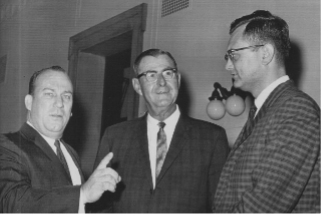
Louisiana’s Attorney General Jack P. F. Gremillion (left), is pictured here, in 1961, with Alabama Assistant Attorney General Gordon Madison (center), and Georgia’s Assistant Attorney General E. Freeman Leverett (right). They gathered at a New Orleans courthouse for a hearing on the constitutionality of Louisiana’s ongoing efforts to resist the desegregation of its schools. (UPI, Central Press Association photograph, August 4, 1961; collection of Helen Knowles-Gardner.)
Gremillion oral arguments
The justices focused on several different aspects of the litigation during the Gremillion oral arguments on April 26, 1961, but one line of questioning stands out. Several justices pressed Schuler for an answer to the following question: when (and how), exactly, in 1956, did the state’s Attorney General “announce” that he was, all of a sudden, going to enforce the 1924 law? “The Attorney General,” Schuler said, “made it general and…and just by conversations, by references in newspaper that he was going to enforce the law.” Schuler’s responses did not sit well with the justices, especially the Alabamian Justice Hugo L. Black, who engaged in the following back and forth:
Black: “What I’m interested in is…is there any statement in here that shows why he said he would decide to enforce that law?”
Schuler: “Offhand I would say it would be his duty. It’s his duty under the statute.”
Black: “I understand that but did, did he make any statement about it?”
A short time later, Justice Felix Frankfurter jumped into the conversation, trying to get Schuler to concede that in all reality, the only announcement that the law would be enforced was when Louisiana initiated the litigation against the NAACP (which is exactly what happened in Patterson). “So far as the record shows,” said Frankfurter, the record “that Justice Black had tried to elicit,” the formal announcement, did not exist; “there is no statement.”
Schuler (with a note of sarcasm in his voice): “Well, if, if you’re going to dress it up into a formal statement…”
Frankfurter (with a decided note of frustration in his voice): “Neither Justice Black nor I want to dress up or dress down, I just want information.”
This line of questioning never led to a conclusive answer about the “announcement” of the enforcement of the 1924 law, and that’s because – as Frankfurter’s incisive questioning demonstrated – such an “announcement” never took place.8
As he was wont to do, Frankfurter was also a very active questioner during the oral arguments in Patterson; and at one point, he accurately captured Alabama’s intentions when he said that the state sought to impose “a death sentence” on the NAACP.9 This is why the questions that he and Black asked of Schuler are best described as rhetorical. Everyone in the courtroom (including Schuler) knew exactly what Louisiana had done, when it had done it, and why it had acted. The justices’ questioning of NAACP General Counsel Robert L. Carter (who was afforded far more opportunities, than Schuler, to speak at length without interruption) merely affirmed this.
Gremillion decision
The Court unanimously decided Gremillion less than a month later. In a short (four-page) opinion, Justice William O. Douglas explained, that “any regulation must be highly selective in order to survive challenge under the First Amendment.” As he eloquently observed:
[a]t one extreme is criminal conduct which cannot have shelter in the First Amendment. At the other extreme are regulatory measures which, no matter how sophisticated, cannot be employed in purpose or in effect to stifle, penalize, or curb the exercise of First Amendment rights. These lines mark the area in which the present controversy lies…
Even though “the case is in a preliminary stage and we do not know what facts further hearings before the injunction becomes final may disclose,” wrote Douglas, the Court still affirmed the preliminary injunction barring enforcement of the law, on the same First Amendment grounds as Patterson.10
AFPF v. Bonta
Fast forward sixty years, to April 26, 2021, when once again the Supreme Court was presented with a case raising important questions about associational freedom. At issue this time was a California rule that compelled charities to disclose the names of their major donors to the state before the groups could solicit in the state. The data sought was slightly different – donors’ details rather than members’ information – but the constitutional problem was the same as that which the Court had addressed in Patterson and Gremillion.
As neatly summarized by IFS Chairman and Founder Bradley A. Smith, the state had made the following demand: “that charities and other nonprofits file IRS Form 990, Schedule B with the state as a condition of remaining ‘registered,’ and hence legally able to solicit contributions, in the state.” This is a major threat to donor privacy because “Schedule B is a simple but, because of its content, highly sensitive form. It is an annual list of names, addresses, and amounts given by major donors (over $5000 or two percent of an organization’s income) to a charity or other nonprofit.” Importantly, “[b]y statute, the IRS is prohibited from making this information public, and while nonprofits must make Form 990 available for public inspection, they may redact the names and addresses of donors from any public inspection.”11
AFPF oral arguments
Less than a minute into the AFPF oral argument, it became clear that this was history repeating itself. To paraphrase the late, great Yogi Berra, it was disclosure déjà vu all over again. Speaking from a lectern, but into a speakerphone rather than to the justices directly in the courtroom (because of Covid protocols), one of the first points that Derek L. Shaffer made in his oral opposition to the California rule was that “Forty-six states today police charities without any such blanket demand. California itself likewise did so for years, Your Honors, without any problems.”12 Just as in Alabama and Louisiana in 1956, when changes in political personnel brought into office state attorneys general hell bent on ousting the NAACP from their jurisdictions, “sometime”13 in the 2010s, right around the time that Kamala Harris became California’s Attorney General, there suddenly emerged an “upfront suspicionless demand for donor information.” The demand furthers our law enforcement goals, the state said. The district court rejected that argument and, as Shaffer emphasized to the justices, the lower court’s finding was “both dispositive and unassailable.”14
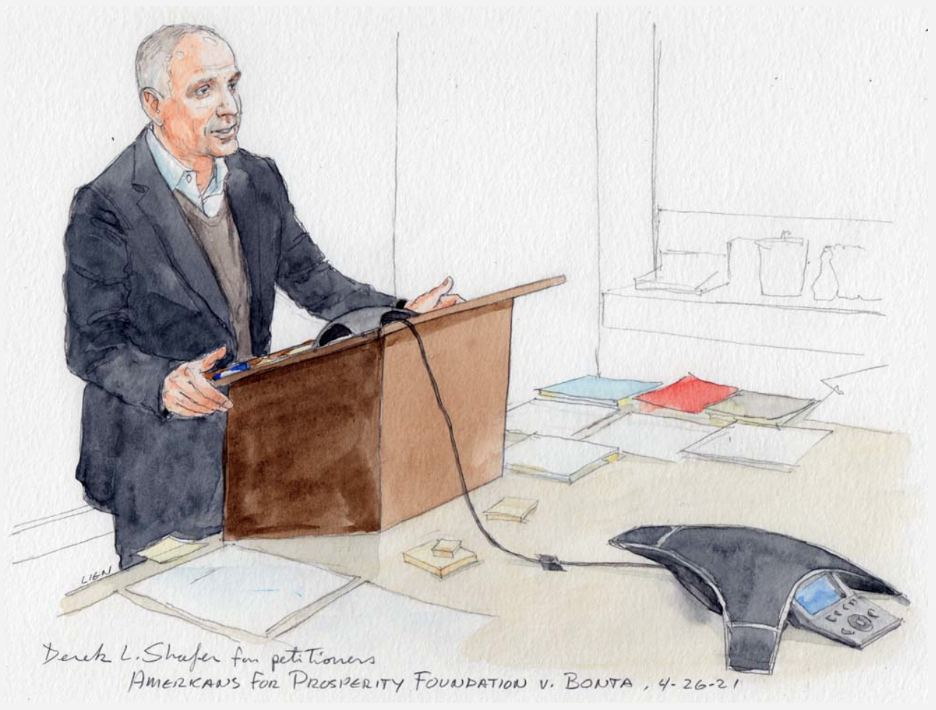
Derek Shaffer participating in the AFPF oral arguments, as depicted by courtroom artist Art Lien (https://courtartist.com/category/supreme-court/arguments/page/2).
A short time later, Shaffer made another important point that further underscored the background similarities between the litigation in Patterson and Gremillion and AFPF. “Let me emphasize there is no law on the books in California requiring Schedule B,” he said. The case involved a challenge not to a California law, but, rather, to “bureaucratic whim.” The state was not interested “in reviewing Schedule Bs.” Rather, it wanted to have “them on hand prophylactically on a suspicionless basis from all charities to then review a tiny handful when an external complaint comes in.”15
To any listeners familiar with the caselaw, it surely can have come as no surprise that Shaffer pointed to both Patterson and Gremillion when the justices engaged him in a related line of questioning about the correct standard of review to apply in the case. Appropriately, when the Chief Justice gave Shaffer one “minute to wrap up,” the counsel for the AFPF once again turned to the case that had been argued before the Court exactly six decades earlier:
We think the rule of law that decides this case is clear, not fuzzy. Even if there may be semantic differences or questions of doctrine as far as strict scrutiny versus exacting scrutiny and least restrictive alternatives versus narrow tailoring being required, this Court’s holding and precedent [is]… clear in Gremillion.16
What a unanimous Court held to be unconstitutional behavior by Louisiana in 1961 was surely no less unconstitutional, six decades later, when the behavior in question was undertaken by California.
AFPF decision
On July 1, a six-justice majority of the Court agreed. The ruling, issued through a majority opinion written by the Chief, made it more difficult for governments to enact disclosure laws that are constitutional. In a major decision for donor privacy, the Court struck down the California rule, holding that the state failed to identify a “sufficiently important” governmental interest for the rule, and that the rule was not “narrowly tailored.” As Smith noted, “Narrow tailoring requires that a statute or policy must not infringe on First Amendment rights in a large number of situations, where doing so does not serve the ‘important’ government interest at stake.”17 Unsurprisingly, Roberts cited both Gremillion and Patterson.18
Importantly, in AFPF the Court also noted the existence of evidence that members of the two petitioner organizations “had suffered from threats and harassment in the past.” Citing Patterson in support of their concerns about the implication of this for First Amendment rights,19 the justices concluded “that donors were likely to face similar retaliation in the future if their affiliations became publicly known.”20 One of Justice Samuel A. Alito’s questions during the AFPF oral argument had cut to the heart of this point. He asked Elizabeth Prelogar (who was at the time, the Principal Deputy Solicitor General of the United States) whether she believed that “donors to organizations that take unpopular positions on hot-button issues have reason to fear reprisals if those donations are made public.” Did Prelogar “think that’s a legitimate fear in our current atmosphere…?”21 Even though she was arguing in support of the California rule, she had to concede that this fear existed, and that it could chill a speaker’s decision to express their views, and to donate to organizations.
Conclusion
The decision in “AFPF shift[ed]…the First Amendment landscape in favor of privacy and the right to association.”22 In so doing, it continued the landmark landscaping begun in Patterson and continued in Gremillion. That the arguments in favor of state disclosure demands made by Louisiana and California met with very similar disapproval during the oral arguments in Gremillion and AFPF on April 26, sixty years apart, is testament to the importance of that date in the Court’s freedom of assembly jurisprudence.
[1] 366 U.S. 293 (1961).
[2] 594 U.S. 595 (2021).
[3] 357 U.S. 449 (1958).
[4] NAACP v. Alabama ex rel. Patterson, Petition for Writ of Certiorari, 19.
[5] 357 U.S. at 462.
[6] NAACP v. Alabama, 360 U.S. 240 (1959); NAACP v. Gallion, 368 U.S. 16 (1961); and NAACP v. Alabama ex rel. Flowers, 377 U.S. 288 (1964).
[7] 366 U.S. at 295.
[8] Louisiana ex rel. Gremillion v. NAACP oral argument audio and transcript, available at Oyez.org, https://perma.cc/G74Y-6LZS
[9] NAACP v. Alabama ex rel. Patterson oral argument audio and transcript, available at Oyez.org, https://perma.cc/DTG5-ZCHA
[10] 366 U.S. at 296, 297, 296.
[11] Bradley A. Smith, “Americans for Prosperity Foundation v. Bonta: Questions and Answers,” August 30, 2021, https://www.ifs.org/research/afpf-v-bonta-primer/
[12] Americans for Prosperity Foundation v. Bonta oral argument audio and transcript, available at Oyez.org, https://perma.cc/6L35-DKM8
[13] Smith, “Americans for Prosperity Foundation v. Bonta: Questions and Answers.”
[14] AFPF oral argument.
[15] AFPF oral argument.
[16] AFPF oral argument.
[17] Smith, “Americans for Prosperity Foundation v. Bonta: Questions and Answers.”
[18] 594 U.S. at 606, 609.
[19] 594 U.S. at 606.
[20] 594 U.S. at 604.
[21] AFPF oral argument.
[22] Smith, “Americans for Prosperity Foundation v. Bonta: Questions and Answers.”
